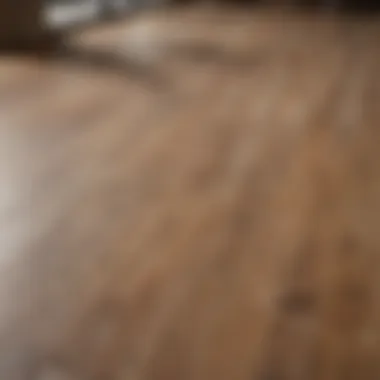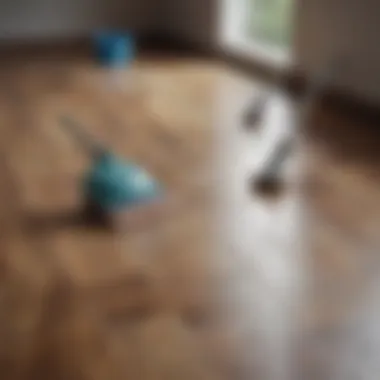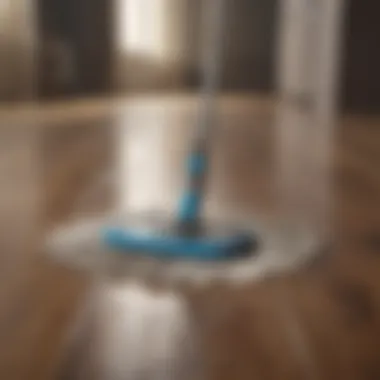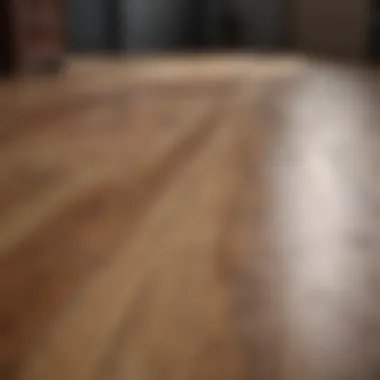Techniques to Effectively Clean Residue from Laminate Floors


Intro
Laminate floors are a popular choice for many homeowners due to their affordability and aesthetic appeal. However, keeping these floors looking pristine can be challenging. Residue builds up over time, whether from cleaning products, foot traffic, or food spills. If left unchecked, this residue can detract from the beauty of laminate flooring and even damage it in the long run.
Understanding the significance of proper cleaning methods is not just about aesthetics; it also relates to the durability of your laminate floors. Dust and grime may seem like minor nuisances, but over time, they can cause scratches and dullness that can be quite difficult to rectify. To keep your laminate floors inviting and shiny, let’s dive into how to tackle these residues efficiently.
Common Types of Residue
Different daily activities in your home can leave various types of residue on laminate floors. Some common offenders include:
- Food and Beverage Spills: Items like juice, coffee, or grease can leave sticky residues.
- Cleaning Product Residue: Over-application or improper cleaning products can leave traces.
- Dust and Dirt: Regular foot traffic brings in dirt and dust, leading to build-up.
- Pet Hair and Dander: If you have furry friends, they contribute to both hair and dander residues.
Understanding what you're dealing with is crucial for effective cleaning.
Tools and Materials Needed
To remove residue effectively, you'll want to gather a few essential items. These tools will help you tackle various types of stains and residues efficiently:
- Microfiber Mop or Cloth: Gentle on surfaces and great for picking up debris.
- Broom or Vacuum: For regular maintenance and to remove larger particles.
- pH-neutral cleaner: Essential in avoiding damage to the laminate while cleaning.
- Soft-bristle brush: Helpful for stubborn residue in crevices.
- Water: Simply rinse your mop or cloth regularly while cleaning.
These provisions will set the stage for a thorough cleaning process.
Step-by-Step Techniques
To get your laminate floors back to their sparkling best, follow these methodical steps:
- Sweep or Vacuum: Remove loose dirt and dust to prevent scratches during the cleaning process.
- Create Cleaning Solution: Mix a few drops of a pH-neutral cleaner with warm water in a bucket.
- Mop Effectively: Dip the microfiber mop into the solution, wring out excess water to avoid over-saturating the floor, and begin mopping. Work in small areas, moving in the direction of the planks.
- Tackle Stains: For stubborn stains, use a soft-bristle brush dipped in the cleaning solution, gently scrubbing the affected area.
- Rinse the Mop: Frequently rinse your mop or cloth to avoid spreading residues around.
- Final Touch: Dry with a clean, dry microfiber cloth to prevent water spots.
"Preventative measures are always better than a cure—regularly maintaining your floors can significantly reduce the need for intensive cleaning."
Preventative Care for Laminate Floors
Keeping your laminate floors looking their best requires more than occasional deep cleaning. To ensure they remain residue-free, consider these tips:
- Use Door Mats: Prevent dirt from coming in by placing mats at entryways.
- Regular Dusting: Dust at least once a week to prevent the build-up of dirt.
- Careful Product Choice: Opt for cleaning products that are safe for laminate floors and don't leave sticky residues.
- Promptly Clean Spills: Acting quickly on spills can prevent residues from setting in deeply.
By actively taking steps to maintain your laminate floors, you can keep them shining without the fuss of extensive cleaning sessions.
In essence, tackling residue on laminate floors is about understanding what you're dealing with, employing the right tools, and establishing a consistent maintenance routine. With these techniques, your floors can be both functional and fashionable—making your space feel welcoming and well-kept.
Understanding Laminate Flooring
Understanding laminate flooring is crucial for effective care and maintenance, particularly when addressing residue removal. Familiarizing oneself with this type of flooring brings a lot of benefits. For one, it allows homeowners to appreciate the nuances of their flooring, enabling them to pinpoint potential issues and respond swiftly before minor problems escalate.
Laminate flooring is built to mimic the look of hardwood, stone, or tile, and is known for its durability and cost-effectiveness. It consists of multiple layers, with a photographic layer capturing the appearance of natural materials, a core layer adding strength and stability, and a backing layer that provides moisture resistance. This construction grants it a distinct advantage: ease of installation and versatility in design. Renovators looking to create a specific aesthetic without breaking the bank often turn to laminate as an alternative.
However, there are considerations to keep in mind. The loose installation method—often floating—makes laminate more vulnerable to damage from standing water or excessive moisture. Furthermore, improper cleaning techniques can lead to a buildup of residues that detract from its appearance. Knowing these aspects allows homeowners to take proactive steps in maintaining the integrity of their floors.
"A stitch in time saves nine." Looking after laminate flooring from the start can prevent undue wear and tear, ensuring longevity.
Characteristics of Laminate Floors
Laminate floors come with various characteristics that set them apart. Here are some of the key features:
- Durability: Laminate is resistant to scratches and dents thanks to its hard surface. This makes it a preferred choice in households with pets or children.
- Variety: Available in countless designs, laminate can emulate many natural surfaces, giving homeowners flexibility in style.
- Low Maintenance: Basic sweeping and occasional mopping are typically sufficient to keep laminate looking fresh.
- Eco-Friendly Options: Many laminate products are made from recycled materials, appealing to environmentally conscious consumers.


These characteristics contribute to the growing popularity of laminate floors. They are not only visually appealing but also offer a practical flooring solution for various lifestyles.
Common Issues with Laminate Floors
While laminate flooring has clear benefits, it also faces several common issues that can arise over time:
- Moisture Damage: Despite a moisture-resistant backing, laminate floors can warp if exposed to excessive water. It's crucial to clean spills promptly to minimize this risk.
- Scratches and Scuffs: Heavy furniture or pet claws can leave marks on the surface. Using furniture pads under legs can help alleviate this.
- Buildup of Residue: Over time, improper cleaning can lead to a film that dulls the luster of the surface. Understanding how to remove such residues is vital for preserving the floor's appearance.
Addressing these problems requires an informed approach, focusing on proper cleaning protocols and general maintenance tips that can prolong the life and beauty of your laminate flooring.
Identifying Residue Types
When it comes to laminate floors, knowing the different types of residue is half the battle. Identifying residue types not only simplifies the cleaning process but also helps in selecting the right technique and products. Different residues may require different approaches, so understanding what you're dealing with can save time and effort. Plus, it adds a layer of thoughtfulness to floor care, allowing one to maintain their living space in top shape.
Manufacturing Residues
Manufacturing residues are often overlooked. These can be remnants from the production process that might be left on the floor after installation. The particles may include sawdust, adhesives, or chemical residues from the laminate material itself. Each of these can affect how clean your floor looks and feels. Without proper identification, one might end up applying the wrong cleaning solutions, which could potentially damage the laminate surface.
To effectively tackle manufacturing residues:
- Vacuum thoroughly: A good vacuum can lift fine dust and particles that are easy to miss.
- Damp mop with a gentle cleaner: Choose a cleaner that specifies it’s safe for laminate surfaces to avoid scratches or dulling of the finish.
Cleaning Product Residues
It’s not unusual for cleaning product residues to build up over time, especially if the same products are used repeatedly without proper rinsing. These residues can manifest as streaks or a waxy film that dulls the shine of the floor. Some common culprits may be multi-surface cleaners or wax-based products.
If you find the floor has a sticky or greasy feel, it’s a sure sign that cleaning residues are at play. Here are some steps to deal with them:
- Mix a vinegar solution with water: This can help cut through the buildup.
- Mop with a microfiber cloth: It's gentler and more effective at removing residues without scratching the floor.
Natural Build-up from Daily Use
Over time, natural build-up occurs from day-to-day activities. Sweeping dirt, dust, pet hair, or spills can accumulate, creating a layer that’s unsightly and unsanitary. This type of residue is often easy to ignore until it becomes significant, creating a dull appearance that simply doesn't shine like it should.
Proactive measures are key here:
- Regular sweeping: This prevents dirt from grinding into the surface.
- Spot cleaning: Attend to spills immediately to minimize buildup.
- Deep cleaning every few months: This not only refreshes the look but also maintains the laminate’s integrity.
Staying ahead of residue types can ensure your laminate floors not only look their best but function better too.
Identifying these residues equips homeowners with the knowledge necessary for effective cleaning, keeping their laminate floors not just clean, but inviting and beautiful.
Essential Cleaning Supplies
Cleaning laminate floors effectively requires the right tools and substances. Using the appropriate cleaning supplies not only simplifies the task but also ensures that no damage occurs to the floor. Many will assume that all cleaning solutions work on laminate; however, this isn’t always the case. Some can leave streaks or even harm the finish.
When discussing essential cleaning supplies, one must consider how they interplay with the laminate surface. A good cleaner does more than just remove dirt; it can also help maintain the sheen of the flooring, making for a more aesthetically pleasing space. Thus, proper selection of cleaners means you won’t be stuck with a dull-looking surface down the line, which is something every homeowner wants to avoid.
Recommended Cleaners
Not all cleaners are created equal, especially with laminate flooring. It's important to choose those specifically formulated for this type of surface.
- Laminate Floor Cleaners: These are specially designed to clean the laminate without leaving residues. Brands like BONA and ZEP offer formulations that lift dirt without harsh chemicals, ensuring the glossy finish is retained.
- Vinegar and Water Solution: A natural alternative, combining equal parts vinegar and water creates a powerful yet gentle cleaning solution. Vinegar cuts through grime without leaving a film, making it a popular choice among many homeowners.
Tools Required for Effective Cleaning


Cleaners work effectively when paired with the right tools. The correct tools enhance the cleaning process and also protect the laminate floor from scratches and other damage.
Microfiber Mop
A microfiber mop is a key tool for any laminate cleaning regimen. Its unique fibers trap dirt and dust better than traditional mops. This results in a deeper clean and less streaking, a common issue with inferior mops.
The beauty of a microfiber mop lies in its versatility. It is gentle yet effective, so it won’t scratch the floor. Plus, many mops come with washable pads, making them environmentally friendly and cost-effective in the long run. Just remember to use them dry or slightly damp to avoid excess water that can warp the laminate.
Soft Cloths
Soft cloths are another essential supply. Their purpose is simple yet effective – to polish and detail areas that the mop might miss. Unlike rough rags, soft cloths won’t leave scratches or lint behind. They work well with cleaners and can help reach into grooves or corners that need extra attention.
A salient point with soft cloths is their absorbency; they can soak up spills quickly, preventing liquid from seeping into the laminate. Older, worn-out cloths, though, might not offer the same efficacy, so keep these replacements handy.
Scrubbing Pad
Using a scrubbing pad on laminate floors calls for some caution, yet it can be beneficial for stubborn spots. These pads can effectively lift stains or buildup but should be used judiciously to avoid scratching the surface.
One should always opt for non-abrasive scrubbers, as harsh ones can cause damage. If the scrubbing pad is made from a softer material, it often works just as effectively on tough stains without the risk. It’s this careful balance that makes a scrubbing pad a potentially valuable tool in your arsenal.
Using proper cleaning supplies is half the battle when it comes to preserving the life and appearance of your laminate floors.
As a summary, when it comes to essential cleaning supplies for laminate floors, the focus should be on using effective cleaners and the right tools. This combination maximizes cleaning potential while minimizing risks to the floor's integrity. By choosing wisely, you can enjoy long-lasting, pristine laminate floors.
Detailed Cleaning Techniques
Effective cleaning methods are essential for maintaining the aesthetic appeal and longevity of laminate floors. In this section, we will explore several key techniques to help you address any residue build-up effectively. The right strategies can not only help restore the shine but also prolong the life of your flooring.
Spot Cleaning Methodology
Spot cleaning is a focused approach that targets specific areas with visible residue. This technique is crucial for small stains or spills that require immediate attention to prevent further damage. When you spot clean, you can use a gentle cleaner applied with a soft cloth or sponge. Treating spots as they occur helps avoid a build-up of grime across the floor, making overall cleaning tasks more manageable.
Key steps to remember include:
- Identify the area needing attention.
- Use a mild cleaner or vinegar solution on a cloth.
- Pat gently but firmly until the residue lifts.
Mopping Strategies
Regular mopping is a cornerstone of floor maintenance, ensuring that your laminate surfaces look their best. A well-planned mopping routine can reduce the frequency of deep cleaning, saving time and effort. It’s best done weekly, depending on foot traffic. Always use a damp (not soaking) microfiber mop as excess water can warp lamination.
Tips for effective mopping include:
- Start at the farthest corner and work your way to the exit.
- Use a cleaner specifically formulated for laminate or a weak vinegar solution.
- Rinse your mop regularly to prevent spreading dirt around.
Dealing with Stubborn Residues
Sometimes the residues you encounter won’t budge easily. For those tough spots, here are two recommended options:
Using Vinegar Solution
Vinegar is a time-honored remedy for more than just salad dressing. Its acidity helps break down stubborn stains or residues. The key characteristic of using vinegar lies in its natural disinfectant properties, making it a popular choice among homeowners striving for eco-friendly solutions. Combine one part vinegar with three parts water for a gentle but powerful cleaning solution.
- Advantages: Non-toxic, cost-effective, and it can leave a streak-free shine.
- Disadvantages: Its strong scent can be off-putting, and it should never be used undiluted on laminate.
Utilizing Baking Soda


Baking soda is another invaluable tool for those particularly stubborn smudges. It has an alkaline nature that tackles grease and grime remarkably well. Known for its versatility, baking soda can be mixed with water to form a paste, allowing it to adhere to residues for effective lifting.
- Advantages: Gentle on surfaces, effective against grease, and it won’t harm the laminate’s finish.
- Disadvantages: Might require a bit of elbow grease to work into tough spots effectively.
"Choosing the right cleaning technique for your laminate flooring can make all the difference in maintaining its integrity and beauty over time."
Preventing Residue Accumulation
When it comes to maintaining laminate floors, the old saying "a stitch in time saves nine" rings true. Proactively taking steps to ward off residue buildup is immensely important. Not only does it simplify your cleaning routine down the line, but it also preserves the aesthetic appeal and longevity of your flooring. Residue can sneak up on you, creating unsightly patches and dulling that otherwise vibrant finish. So, let's break down the various facets of prevention to keep your laminate floors looking spick and span.
Routine Cleaning Practices
Keeping a consistent cleaning schedule is paramount. By sweeping or vacuuming your floors every few days, you can easily minimize dirt that naturally accumulates. Here are a few additional practices to consider:
- Use a microfiber mop weekly. Microfiber is excellent for picking up fine particles and dust without scratching.
- Spot clean spills immediately. This ensures that sticky residues don’t have the chance to set in.
- Change cleaning pads regularly. Dirty pads can just spread grime back onto the floor rather than lift it away.
Choosing the Right Products
Selecting quality cleaning products can make a world of difference. It’s essential to pick those that cater specifically to laminate flooring to avoid damage. Consider the following:
- Avoid harsh chemicals that can strip the protective finish of your floors.
- Look for pH-neutral cleaners. They’re effective but gentle enough that they won’t cause wear.
- Test new products on a small area first to make sure they don’t discolor or harm your floors.
Protective Measures
Taking steps to shield your laminate floors from potential damage is another essential practice.
Using Area Rugs
Area rugs can be a game-changer. They add character to your space while serving a practical purpose. When strategically placed, they absorb foot traffic and moisture, which can help reduce the likelihood of discoloration or grime buildup. Plus, you can easily toss them in the wash whenever they need a freshen up.
However, it’s important to select rugs with a non-slip backing. This keeps them in place and avoids accidents. The downside is that they need regular cleaning, since dirt can accumulate on the rugs themselves, leading to additional cleaning needs.
Implementing Furniture Pads
Furniture pads act like silent guardians, protecting your floors from scratches and scuffs. Whether they are felt or rubber, they provide a cushion beneath heavy furniture so that any movement doesn’t mar the surface. One significant advantage is that using pads can reduce wear in high-traffic areas, prolonging the life of your laminate.
Just make sure to check the condition of these pads occasionally. Worn-out or dirty pads can become counterproductive. In the end, implementing these measures is a proactive approach, ensuring your floors remain as dazzling as the first day they were installed.
"An ounce of prevention is worth a pound of cure."
By taking the time to prevent residue accumulation before it starts, the task of cleaning becomes far more manageable. After all, who wouldn’t want to keep their home looking its very best without breaking a sweat?
Reassessing Laminate Floor Care
Caring for laminate floors goes beyond just the occasional sweep and mop; it’s about creating a long-term relationship with your flooring. Reassessing laminate floor care is crucial for maintaining the aesthetic appeal and durability of your floors. Many homeowners neglect this aspect, thinking that a quick clean will suffice. However, understanding the nuances of laminate floor maintenance can mean the difference between well-preserved surfaces and floors that require costly repairs or replacements down the line.
Regularly revisiting your cleaning routine provides an opportunity to adjust your practices based on the wear and tear your floors experience. Each household varies—some have pets that bring in dirt, while others might have high foot traffic. This variability demands a tailored approach to care. Incorporating new techniques or products might be necessary to combat evolving residue types and environmental factors.
To sum it up, an ongoing evaluation of floor care strategies not only helps keep your laminate looking like new but also maximizes its lifespan. Engaging with your flooring in this thoughtful way showcases your commitment to maintaining a healthy living space.
When to Seek Professional Help
Sometimes, despite best efforts, laminate floors can appear dull or accumulate residue that just won’t budge. This is the moment when seeking professional cleaning services becomes a consideration. If you start noticing scratches that seem untenable or dark stains that don’t lift even with thorough scrubbing, it may be time to call in the pros.
Hiring a professional service can bring specialized equipment and cleaning agents designed for specific residue issues. These experts can assess the condition of your floors and recommend tailored solutions, which might not be readily accessible to homeowners.
It's smart to remember that some flooring manufacturers mandate professional cleaning after a certain period to maintain warranties. So, not only can it save you from further aggravation, but it may also preserve your investment.
Long-term Maintenance Considerations
Maintaining laminate flooring isn’t a one-off task; it's a continual process. Regular maintenance not only enhances the floor’s appearance but also prevents build-up over time. Here are some ideas worth considering:
- Consistency is Key: Create a schedule for cleaning based on the foot traffic in your space. Weekly vacuuming and a bimonthly deep clean can make a tremendous difference.
- Protective Measures: Use furniture pads to guard against scratches and stains. Area rugs can also help trap dirt before it hits the laminate surface.
- Expand Your Knowledge: Stay updated on the latest cleaning products and techniques. What worked a year ago might not be as effective today.
- Stay Vigilant: Pay close attention to changes in how your floor feels or looks. If something seems off, addressing it quickly can prevent larger issues.
"An ounce of prevention is worth a pound of cure." It’s a phrase that rings particularly true when applied to laminate floor maintenance. Investing time into long-term care can yield significant dividends in the life of your floor.







